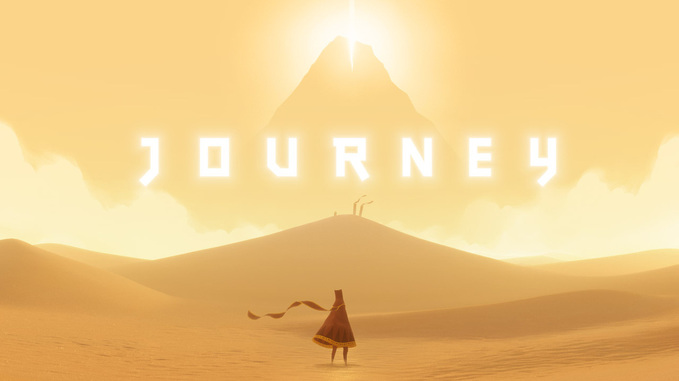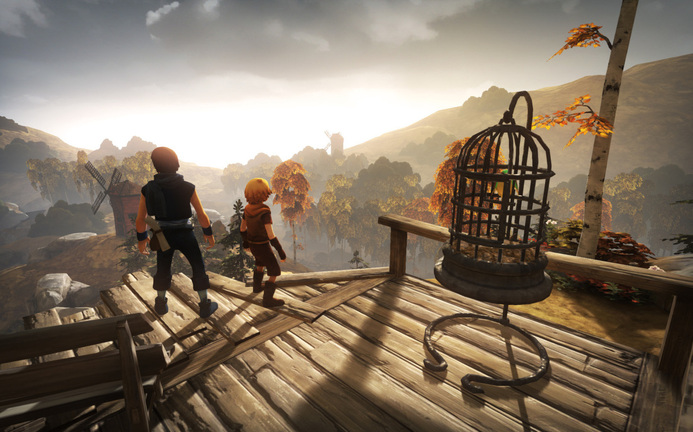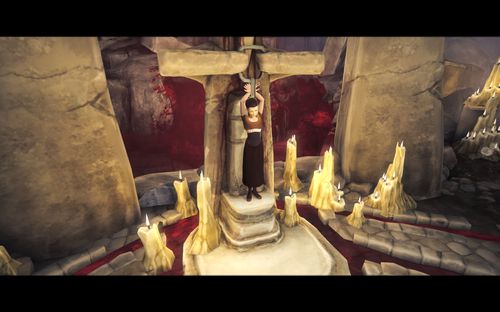I think that Journey is especially hard for me to breakdown into specific sections. It is a great example of a smooth narrative told through gameplay. I'll do my best here, but there are several different levels that almost stand apart as their own little narratives in the game.
Here is a video of the beginning of the game. It's even more sparse an opening than Ico or Shadow of the Colossus. thatgamecompany relies very heavily on sound and image. But, the title and the opening shots still give you a clear idea of the purpose of the game.
You'll spend the majority of the game enjoying the sights and sounds while exploring. And, hopefully, you'll be doing that alongside an anonymous partner. That is one of the most clever things about Journey: you are matched up with another player online, but you're not given their name or any way to properly communicate. All you are able to do is set off a series of chime-like emotes to signal that you're there, or that you want them to come to where you are. When you're close to your partner, your scarf will glow as if being replenished. I wish I could link to a video that conveys what it is like, but I don't think there is one single video. It's a very unique experience to discover this with another player. You can usually tell if you're with someone that has already learned the limited form of communication, or if you're watching someone pick it up for the first time. It was really intriguing for me. If you managed to play through Journey without coming across someone, I highly recommend you go back and play it online.
Again, like the exploration, you are free to engage or ignore your partner as much as you like. If you move on ahead or lag behind, you'll eventually be matched up with another partner.
All of this; the exploration, the sensory pleasure, the temporary but still impactful meetings with strangers; is building into the story of Journey. And, just as the name implies, it isn't about where you're going. The heart of the story is the experience of getting there and the bonds you form.
Later in the game, there are dangers that you must avoid. In one level, huge monsters of cloth swim through the air. They attack if you're caught out in the open, and though there is only a minor consequence (losing length off your scarf), it feels like a scary encounter. This, like most of the game, is amplified when you see your partner get attacked. Maybe you've been figuring out puzzles together for several levels, and now you see your friend struck down by one of these things. Or maybe you've just stumbled into a new partner, and them getting knocked flying is the first thing you see of them. Either way, it makes the already foreboding atmosphere even more threatening. The game was built around how journeys feel when you share them, not just when you take them on your own.
The end of the game is a difficult slog up that mountain that was glimpsed from the beginning. The freedom of floating about wide-open ruins or racing down a sandy slope is completely gone. Now, the journey is grueling; you are pushed back by wind. You come to a final slope, and as you push up it, you begin to freeze.
When I first did it, I was with a partner I had played with for several levels. I was hoping to see the end of the game with them. But as my scarf became frozen and the glow became weak, I started to worry. I tried to "boost" my partner by using the same command that had worked throughout the game. But now, it was a weak little pulse instead of the normally bright effect. The game ended with me hoping that if I didn't make it up, my "friend" would. Then, it fades to white.
And then you're greeted with this:
The game has, in essence, a looping narrative. You finish this epilogue level, and are brought back to the beginning. A reincarnation so that you can do the journey again. And the second time you walk through that field of tombstones, you definitly understand what they mean.
That doesn't seem to hinder the designers in any way though. The game opens with a cinematic of the younger brother (just called Little Brother) unable to save his mother from drowning while out on a boat. Shortly after, we're introduced to his father and Older Brother. The father has gotten very ill, and so the brothers must carry him to a kind of healer further into the village.
At this point, the player has to deal with the bizarre but brilliant control scheme. The right analog stick and right trigger control one brother, and the left stick and trigger control the other. So, even though this is a single player game, it feels a little bit like a co-op all the way through. Certainly, you feel the connection grow between the two brothers as you navigate them and solve puzzles in which they have to work together.
In fact, the beginning of the game sets up some important concepts based on this. The little brother can be boosted up by the big brother and can fit in small spaces. The big brother can pull large levers and do other heavy lifting tasks. But most importantly, the little brother is terrified of water, and he'll only get in if he can hitch a ride on his big brother. To do this, you need to hold the action buttons for both brothers and move them through the water.
After going to the healer and learning that the only hope for your father lies with a magical tree in a faraway place (again, all through image and sound), you walk the brothers through the village. These village scenes are excellent in that they help draw you into the medieval/fairy-tale world, while also showing that the brothers are individuals. There are several places where you can use either brother for an action, and the game shows how they are different. This is one of my favourite examples.
Once they're out of the village, the game's tone shifts gradually. The dangers that the brothers face become real, and they encounter some very dark scenes. There is a scene in which Little Brother is knocked unconscious and he relives his shame at not being able to save his mother. There is a battlefield covered in the corpses of giants. There is a man that tries to hang himself because his family died in a fire. All through this, there is still a sense of adventure--sometimes even humour. But those points become less and less and frequent until you meet the girl.
This leads into the brutal ending of the game. Not only is the older brother killed by the girl, but the game even gives you false hope in the magical liquid retrieved from the tree. Those few moments after you pour the liquid into the older brother's mouth, waiting to see if you can really bring him back, are agonizing.
Then, you're given a quick montage of the little brother's journey back to the village, but there are still a few challenges left. It's in this final section, where you have to get back to the village proper through stormy waters, that the marriage of mechanics and story really shines. The scene looks almost exactly like the one in which the mother drowned, and Little Brother still can't swim (at least, that's how it seemed to me). Then, I realized that you could still hold both triggers, and he would struggle through. The older brother's trigger now allowed him to conquer his fear and return with the cure to his father. The game even vibrates the controller to add the feeling of resistance that Little Brother must feel. After the swimming, you pull a lever that before you couldn't have, and you jump up to a previously unreachable ledge. Each time, you use that hand that until now has controlled the older brother to help the little brother along. This nice little conceit ties in the cooperative feel of the game.
The epilogue to this game also features a bittersweet flyby of the locations that were seen on the journey, though this one isn't as removed from reality. The game, in fact, drives home the point by showing the little brother and the father in front of the family plot that now has two tombstones. Still, it seems that just like other designers, Starbreeze realized that a little relief is needed after playing such sombre endings.
That's it for this look at story games with no words. I hope you've enjoyed it, and I apologize that this one went up a week later than planned. I'd love to hear any comments you have, especially if you know of any other games that fall into this same kind of category.



 RSS Feed
RSS Feed